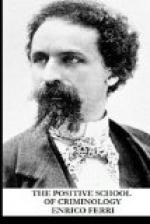On the one hand, human life depends on the word of a judge, who may err in the case of capital punishment; and society cannot end the life of a man, unless the necessity of legitimate self-defense demands it. On the other hand, solitary confinement came in with the second current of the classic school of criminology, when at the same time, in which Beccaria promulgated his ideas, John Howard traveled all over Europe describing the unmentionable horrors of mass imprisonment, which became a center of infection for society at large. Then the classic school went to the other extreme of solitary confinement, after the model of America, whence we adopted the systems of Philadelphia and Harrisburg in the first half of the nineteenth century. Isolation for the night is also our demand, but we object to continuous solitary confinement by day and night. Pasquale Mancini called solitary confinement “a living grave,” in order to reassure the timorous, when in the name of the classic school, whose valiant champion he was, he demanded in 1876 the abolition of capital punishment. Yet in his swan song he recognized that the future would belong to the positive school of criminology. And it is this “living grave” against which we protest. It cannot possibly be an act of human justice to bury a human being in a narrow cell, within four walls, to prevent this being from having any contact with social life, and to say to him at the end of his term: Now that your lungs are no longer accustomed to breathing the open air, now that your legs are no longer used to the rough roads, go, but take care not, to have a relapse, or your sentence will be twice as hard.
In reality, solitary confinement makes of a human being either a stupid creature, or a raving beast. And “s’io dico il vero, l’effeto nol nasconde”—if I speak the truth, the facts will also reveal it—for criminality increases and expands, honest people remain unprotected, and those who are struck by the law do not improve, but become ever more antisocial through the repeated relapses. And so we have that contrast which I mentioned in the beginning of my lecture, that the theoretical side of criminal science is so perfected, while criminal conditions are painfully in evidence. The inevitable conclusion is the necessity of a progressive transformation of the science of crime and punishment.




